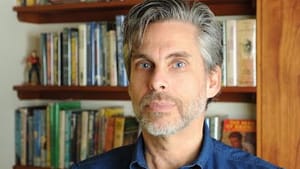Stay in the Loop
BSR publishes on a weekly schedule, with an email newsletter every Wednesday and Thursday morning. There’s no paywall, and subscribing is always free.
Bottling up history
Michael Chabon's 'Moonglow'

In Michael Chabon’s new novel, Moonglow, the narrator sits mesmerized at his grandfather’s deathbed as the sick man, “sculling along the surface of a sea of pain,” finally divulges details about the family’s past.
The grandfather tells the story of his life and simultaneously that of a broader historical context. He meanders into previously hidden corners of pre-war Philadelphia, of the invasion of Germany, of a Florida retirement village, of New York’s Wallkill Prison, and of the space program, his grandfather’s rocket obsession coming to the fore. As the narrator (ostensibly a stand-in for Chabon) digests the narratives he has never heard before — a new take on his family’s history and his country — all within the space of a week, the reader perches right beside him, just as engrossed.
Fiction in truth
Chabon’s grandfather really did reveal only at the last minute long-buried family anecdotes and secrets. This knowledge causes the reader to wonder what to believe, making Moonglow feel almost cinematic in its unfettered mixture of the imaginary and the real. Gnawing at the novel’s edges are persistent questions about the dimensions of Chabon’s mythmaking, about the fun he might be having by testing the reader’s gullibility.
“People ask me how much of this is really true,” Chabon said at a December 8, 2016 reading at the Free Library of Philadelphia. “The answer is Moonglow — all 430 pages of it.” He explained that he viewed fiction as a way, not of conveying “facts” but for communicating a “truth.”
“Memory is so fragile,” Chabon added. “It’s so liable to fictionalizing; it might even be the case that it is a fiction.”
Picturesque language
But while the novel sometimes veers toward entanglement in the questions it raises and the intricacies of its own plot, Chabon knits together the story, and holds the reader’s attention, with his fluid language and arresting description.
The narrator’s grandfather emerges from a prison stint to find the family’s hickory tree “rigged in sails of fire.” On a hunt for a python, the grandfather’s partner’s “belly sloshed in the wine-skin of a ribbed undershirt.” The temperature registering 95 degrees, “across the feral golf course on the other side of the fence, a million insects played a one-note tone poem entitled Heat.” Redbrick Baltimore row homes, “clad in white siding,” make the narrator’s mother “think of gums crowded with teeth.”
Also cohering the novel’s disparate parts is the theme of “moonglow” itself. It becomes a metaphor for illuminating the past, like the “moonlight welling in [an] old priest’s eyes” that Chabon’s grandfather saw during a deep-night discussion in war-torn Germany. The tragedy is that this enlightenment only happens in the final moments of his grandfather’s life, as he moves “toward the story on the opposite shore that [is] waiting to begin.” Ultimately, Moonglow explores what it means to bottle up history — that of one’s family, one’s country, one’s century — until it’s nearly too late to understand it.
What, When, Where
Moonglow. By Michael Chabon. Harper; First Edition edition, 2016. 448 pages, hardcover; $17.39, available at amazon.com.
Sign up for our newsletter
All of the week's new articles, all in one place. Sign up for the free weekly BSR newsletters, and don't miss a conversation.
 Courtenay Harris Bond
Courtenay Harris Bond